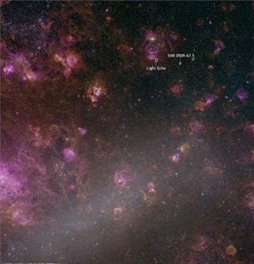 I don’t know about you, but personally I’d want to get as far away as possible if I was in the vicinity of a supernova – a massive cosmic explosion with the energy of millions and billions of nuclear bombs. In fact, in the short period when the supernova is taking place, the same amount of energy is emitted as the Sun produces in its entire lifetime.
I don’t know about you, but personally I’d want to get as far away as possible if I was in the vicinity of a supernova – a massive cosmic explosion with the energy of millions and billions of nuclear bombs. In fact, in the short period when the supernova is taking place, the same amount of energy is emitted as the Sun produces in its entire lifetime.
Even here on Earth, supernovas millions of light years away can be seen as bright blobs in the sky. When the star Betelgeuse (about 400 light years away) explodes into a supernova, it’ll be so bright you’ll be able to read outside in the middle of the night. Amazingly, Betelgeuse is ready to explode at any moment now – it could even have happened by the time you finish reading this post.
 But supernovas are now giving scientists a bit of a headache. They know that there was a supernova around the year 1600, and it should have been really obvious in the sky – around 300 times brighter than a normal supernova. But not a single record exists in any historical documents from any civilization around at the time.
But supernovas are now giving scientists a bit of a headache. They know that there was a supernova around the year 1600, and it should have been really obvious in the sky – around 300 times brighter than a normal supernova. But not a single record exists in any historical documents from any civilization around at the time.
We know that people cared about supernovas hundreds of years ago, because sailors relied heavily upon the stars for navigation. Back around the year 1000 Chinese scholars noted a supernova that we know today as the Crab Nebula. So why was the 1600 supernova undetected? That’s the problem.
But wait a minute, how can we be certain it happened 400 years ago? Basically, there are some dust clouds located 400 light years away from the supernova that have started to be lit up over the past few decades. If the light is only just reaching the dust clouds it must have set off from the supernova 400 years ago – giving a date of 1600.
 One thought I had is whether religion played a role – back when the Chinese scholars recorded the AD 1000 supernova, Westerners made no mention of it. It is thought that this was because Christianity was so strong that they didn’t dare contradict its teachings that the heavens remain still and motionless. It’s just an idea… who knows the real reasons… I think this cosmic puzzle will be keeping scientists thinking for a long time yet.
One thought I had is whether religion played a role – back when the Chinese scholars recorded the AD 1000 supernova, Westerners made no mention of it. It is thought that this was because Christianity was so strong that they didn’t dare contradict its teachings that the heavens remain still and motionless. It’s just an idea… who knows the real reasons… I think this cosmic puzzle will be keeping scientists thinking for a long time yet.
(By the way, I’m not being anti-religious – I myself am a practicing Christian).
Filed under: Exploration, Nature, Science, Space, Technology | Tagged: astronomy, astrophysics, cosmology, cosmos, crab nebula, news, star, stars, supernova, supernovas | 4 Comments »






